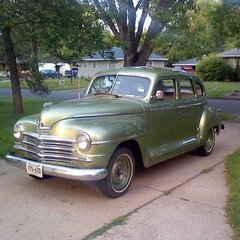-
Posts
2,556 -
Joined
-
Last visited
-
Days Won
83
Sam Buchanan last won the day on February 20
Sam Buchanan had the most liked content!
Reputation
1,649 ExcellentProfile Information
-
Location
North Alabama
-
Interests
custom-built aircraft and boats
-
My Project Cars
1948 Plymouth Special Deluxe
1974 Triumph TR6
1969 VW Beetle
Converted
-
Location
north Alabama
-
Interests
custom-built aircraft
Recent Profile Visitors
The recent visitors block is disabled and is not being shown to other users.
-
If the top of your Savoy is dark green that is the same color combination of the '56 Savoy in which I learned to drive. The concerns you have stated in regard to the condition of your car are pretty much the norm for a Mopar of this vintage, fortunately they are all easily remedied. First thing you need is a service manual. The shifter never was "Miata precise", most likely yours has some worn parts in the linkage. The crunchy 1-2 might be fixed with a premium trans oil like RedLine MTL, that made my '48 shift very smoothly in all temps. If you car has the Lockheed brakes (think it does) you will want to get up to speed on the adjustment routine, it'll be different from anything you have seen. Here is some info: https://p15-d24.com/page/p15d24/tech/brakes.html/ Enjoy your new project, it'll be fun!
-
That diagram is a riot! Just as Abraham Lincoln once said, "Don't believe everything you see on the internet"...................
-
Rich, you might find this thread to be useful: https://p15-d24.com/topic/62606-looking-at-a-1956-dodge-coronet/ 😄
-
If a pin can't be easily sourced I would consider a grade-8 bolt.................
-

Aftermarket Gas Tank Outlet Threads - Which One?
Sam Buchanan replied to hi_volt's topic in P15-D24 Forum
Now the question is whether or not you will need the little brass ferrule found in the original tank to get whatever fitting you use to seal tightly. Straight threads usually need a flared fitting for sealing. -

Coolant leaking out of the clutch housing?
Sam Buchanan replied to temecularevev's topic in P15-D24 Forum
Don't know if I would want that stuff in my rare and expensive honeycomb radiator.................... -

Coolant leaking out of the clutch housing?
Sam Buchanan replied to temecularevev's topic in P15-D24 Forum
I had to drop the oil pan and rear main cap to provide clearance to remove the flywheel bolts so the flywheel could be dropped out of the bell housing. -

Coolant leaking out of the clutch housing?
Sam Buchanan replied to temecularevev's topic in P15-D24 Forum
I think pulling the transmission would be much simpler than pulling the engine. -

Aftermarket Gas Tank Outlet Threads - Which One?
Sam Buchanan replied to hi_volt's topic in P15-D24 Forum
Go to your local auto parts or hardware store and get a brass 1/4" NPT barb fitting and see if it fits your tank, I suspect it will. If it doesn't....go to Plan B. -
Short answer....no. The alternator, regardless of its max rating, will not put out more current than needed to satisfy the loads on your electrical system. In other words, if your old genny put out 30a to accommodate the max load, then the new alternator will output similar current. Nothing gets fried and you can use your existing ammeter.
-
I can be intimidating for the first timer to hit the puller REALLY HARD with a LARGE hammer but the shock of the hammer blows is part of the process in addition to the pressure being created by the puller. As has been stated before, always leave the nut on the axle while using the puller, when the drum releases, all that energy that has applied to the puller has to go somewhere and it can launch an unsecured drum in a way that can cause serious damage and injury.
-

Wilwood Dual Chamber Brake Master Cylinder
Sam Buchanan replied to Sam Buchanan's topic in P15-D24 Forum
I don't know which requires more fluid volume to be moved, drum wheel cylinders or disc pistons, so I don't have a definitive answer on which Wilwood master cylinder is optimum for our application. I added a proportioning valve to the rear brakes but don't see any difference in pedal pressure regardless of how the valve is adjusted. I'm satisfied with the brakes especially when considering the limited traction allowed by the bias-ply tires I use. I failed to address your question about residual valves. I don't have any external valves installed and don't think they are needed. However, I have disc brakes, don't know if that makes a difference. -

Wilwood Dual Chamber Brake Master Cylinder
Sam Buchanan replied to Sam Buchanan's topic in P15-D24 Forum
Dennis, I converted to the Wilwood m/c at the same time the disc brakes were installed so have no experience with the cylinder/drums combination. My comment about the 1 1/8" was due to the pedal on my car not being as firm as I expected. As a rule of thumb a larger bore will move more fluid but require more pedal effort. But my brakes work fine and I think your installation will be fine. When we move away from original equipment we sometimes have to be willing to experiment a bit. -
48ply1stcar started following Sam Buchanan
-

Wilwood Dual Chamber Brake Master Cylinder
Sam Buchanan replied to Sam Buchanan's topic in P15-D24 Forum
I suggest a 1 1/8" bore, the 1" bore of the Wilwood I have works fine but I think the pedal would be firmer with the larger bore. However, I am running disks on front so my experience might not match what you find with drums on front. Once we start mixing non-standard cylinders and brakes we are in the experimental realm. -
I discovered the same thing a few years ago and used an end cap to make an adapter for a pressure bleeder.







